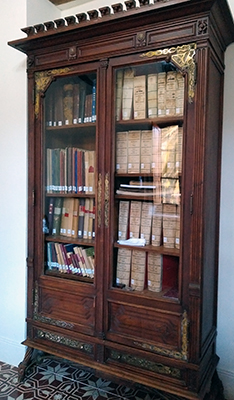Preserving and disseminating our past to look to the future
By Juan Ignacio Lorca Salañer (President of the Fontilles Foundation)

The idea of preserving the Fontilles historical archive and conceiving a museum dates back to 2013. It was put forward by professors Josep Bernabeu Mestre and Antonio García Belmar as coordination meetings were being held between Fontilles and the University of Alicante (UA) together with two collaborative projects: the health and cooperation seminar, which held its sixth edition in 2018, and a project to promote health and nutrition in rural Nicaragua, which was in its third implementation phase in 2019. They believed that given the right conditions, the museum project could be implemented over the years. From 2013 to the present day, not only have countless actions been undertaken, but a growing number of actors are willing to take part. The Library Biblioteca Virtual Miguel de Cervantes (BVMC) and the Sasakawa Health Foundation (SHF) have now joined the project, originally based on the collaboration between the University of Alicante and Fontilles. They are all motivated by the desire to preserve Fontilles heritage and its valuable contribution to Spanish-language science and research. We must therefore describe the context of this work and express our gratitude to the actors involved. We will start with the historian Vicent Comes Iglesias, who, as from 2008, together with Verónica Mas, the Fontilles librarian, collected, ordered, classified and studied all of Fontilles' documentation on the occasion of its 2009 centenary; this work led to the publication of Cuidados y consuelos: cien años de Fontilles, edited by the Biblioteca Valenciana in 2009. It describes the history of Fontilles between 1909 and 2009. This vast collection of documentation was managed and organised at the time and in the following years by the Jesuit Carlos Sancho, the director of Fontilles until 2014.
That same year, in 2014, Jorge Llopis, professor of architectural graphic expression at the Polytechnic University of Valencia (UPV) and a team from the Institute for the Restoration of Heritage of that university, launched the project «The San Francisco de Borja de Fontilles Sanatorium. Model of analysis to fully recover medical facilities of a patrimonial value». This project was a major advance towards recovering the heritage of the Fontilles Sanatorium, regarding both its architecture and its landscape. Above all, the aim was to create and showcase a theoretical model of recovery of old leprosy centres that could be reused by other European institutions similar to Fontilles. From this moment onwards, Fontilles started to build an international network of institutions, universities and hospitals, whether in operation or not, dedicated to caring for people affected by leprosy; in addition to the entities named above, we must mention the University of Coimbra and the Rovisco Pais sanatorium for leprosy patients in Portugal; the San Martino Hospital in Genoa, Italy; the Leprosy Museum in Bergen, Norway; the Greek Ministry of Culture (responsible for the former Spinalonga colony) and the NGOs IDEA (USA) and AIFO (Italy), specialising in defending and protecting people affected by leprosy. Over the years, these latter institutions, together with others that will assuredly take part in this major project, have set up a platform to jointly preserve the memory of historical victims of persecution, isolation, rejection and misunderstanding as well as the memory of the awe-inspiring work carried out by people or institutions which, like Fontilles, fought against this injustice.

In 2015, Fontilles joined the Leprosy Heritage Sites network, a project coordinated by IDEA, including former colonies in Europe and the rest of the world. It aims at preserving the memory of these heritage sites and adapting them to new challenges and needs of today's world. During 2016 and 2017, Fontilles participated in the International Symposium on Hansen's Disease / Leprosy History as Heritage of Humanity, organised in Japan by the SHF. We presented our preservation project as a dynamic social and health project that is useful in today's society. New actors joined our cause. It is then, in 2017, under the direction of Professor Antonio García Belmar and with the financial support of the SHF, that this exciting project began, with the key collaboration of The Miguel de Cervantes Virtual Library, a vital addition to reach the Spanish-speaking scientific community. In this way, we have taken on a major new challenge: that of disseminating this portal in Latin America, and of gaining, with this region, a potential source of inspiration and hopefully of new contributions. If the outcome is successful, we will have fulfilled another initial objective, perhaps our major goal: that our project remains alive, dynamic and growing.